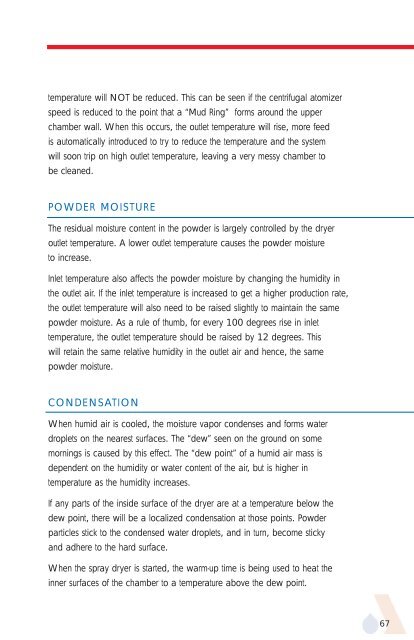APV Dryer Handbook - Umbc
APV Dryer Handbook - Umbc
APV Dryer Handbook - Umbc
You also want an ePaper? Increase the reach of your titles
YUMPU automatically turns print PDFs into web optimized ePapers that Google loves.
temperature will NOT be reduced. This can be seen if the centrifugal atomizer<br />
speed is reduced to the point that a “Mud Ring” forms around the upper<br />
chamber wall. When this occurs, the outlet temperature will rise, more feed<br />
is automatically introduced to try to reduce the temperature and the system<br />
will soon trip on high outlet temperature, leaving a very messy chamber to<br />
be cleaned.<br />
POWDER MOISTURE<br />
The residual moisture content in the powder is largely controlled by the dryer<br />
outlet temperature. A lower outlet temperature causes the powder moisture<br />
to increase.<br />
Inlet temperature also affects the powder moisture by changing the humidity in<br />
the outlet air. If the inlet temperature is increased to get a higher production rate,<br />
the outlet temperature will also need to be raised slightly to maintain the same<br />
powder moisture. As a rule of thumb, for every 100 degrees rise in inlet<br />
temperature, the outlet temperature should be raised by 12 degrees. This<br />
will retain the same relative humidity in the outlet air and hence, the same<br />
powder moisture.<br />
CONDENSATION<br />
When humid air is cooled, the moisture vapor condenses and forms water<br />
droplets on the nearest surfaces. The “dew” seen on the ground on some<br />
mornings is caused by this effect. The “dew point” of a humid air mass is<br />
dependent on the humidity or water content of the air, but is higher in<br />
temperature as the humidity increases.<br />
If any parts of the inside surface of the dryer are at a temperature below the<br />
dew point, there will be a localized condensation at those points. Powder<br />
particles stick to the condensed water droplets, and in turn, become sticky<br />
and adhere to the hard surface.<br />
When the spray dryer is started, the warm-up time is being used to heat the<br />
inner surfaces of the chamber to a temperature above the dew point.<br />
67











